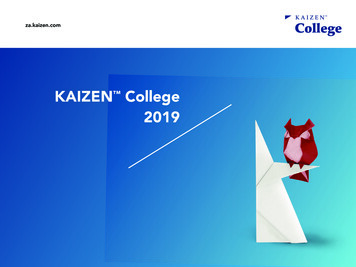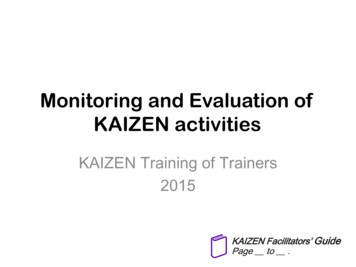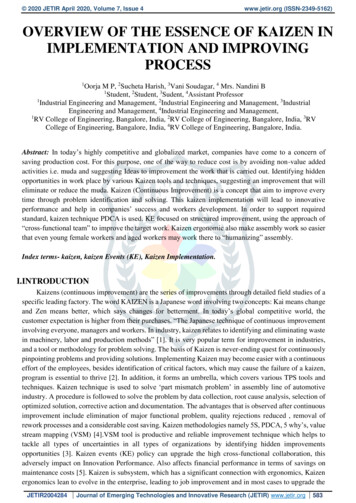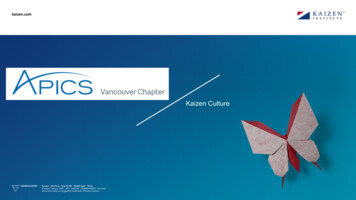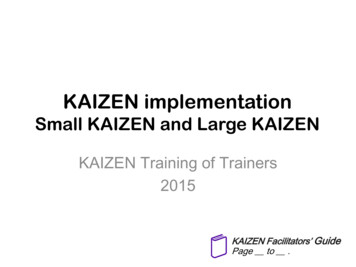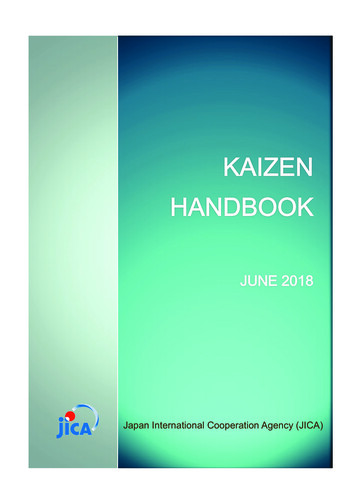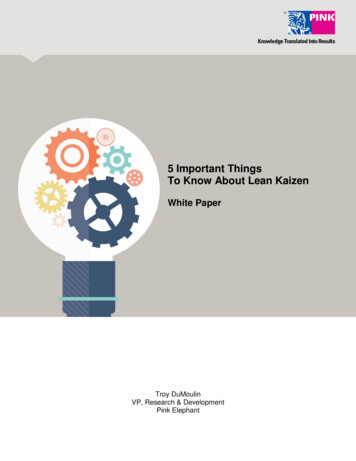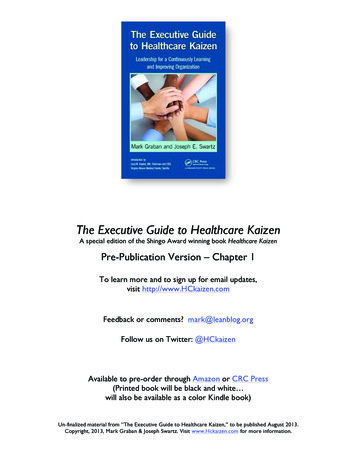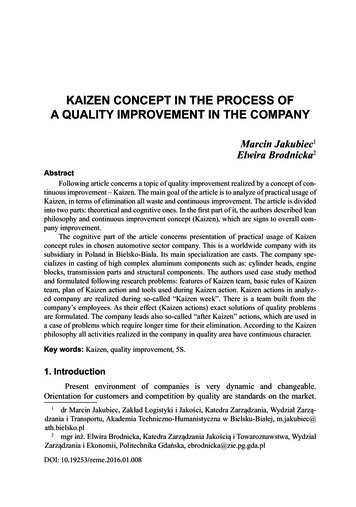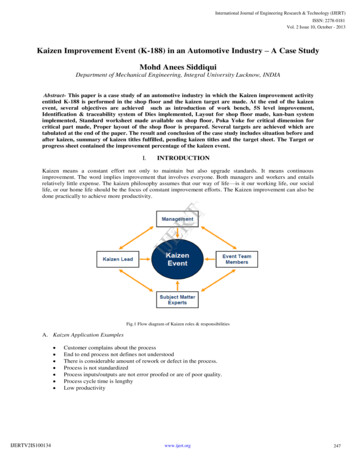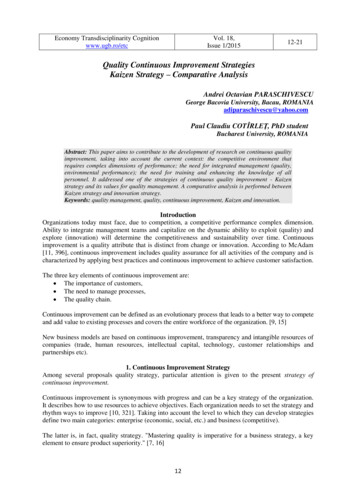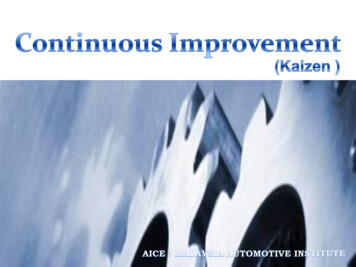
Transcription
Introduction Definition of Kaizen Kaizen Goals Kaizen Key Concepts Phases of Kaizen Basic Tips for Kaizen Activity Process of Kaizen Process Improvement
Kaizen means continuous improvement. Moreover, Kaizen means continuing improvementin personal life, home life, social life andworking life (a way of life) When applied to the workplace, Kaizen meanscontinuing improvement involving everyone –managers and workers alike.Mr. Masaaki Imai (1986)
Japanese word meaning– Kai : gradual and orderly change– Zen : for the better Involves everyone in the organization insmall improvements using conventionalknowledge and tools without large capitalinvestments. Does not require major or drastic changes,while making little changes is sufficient. Focusing on eliminating waste.
Improvement is made by: Viewing all work as a process Making all processes effective, efficient andadaptable Anticipating changing customer needs Eliminating non value added process Using benchmarking to improve competitiveadvantage Innovating to achieve breakthroughs Incorporating lessons learned into futureactivities Using technical tools
1. Company-wide focus to improve processperformance2. Gradual improvement through step by stepinnovation3. Organizational activities with theinvolvement of all people in the company4. Creating a learning and growingenvironment
Everybody deserves to and should be willing toimprove himself/herself for the bettercontinually.“If a man has not been seen for three days,his friends should take a good look at him tosee what changes have befallen him”an old Japanese saying thatdescribes how natural Kaizen is
PDCA – standardized work Quality first– If something can be improved, a measuremust exist by which improvement can bequantified – quality characteristics Upstream management Speak with data Variability control and recurrenceprevention
Activity Aim :Improvement on productivity, quality performance,safety, cost, working environment, systemeffectiveness and efficiency while reducing waste.Benefits :Reducing inventory, rework and scrap, materialtravelling, over production, poor quality, spaceutilization, better allocation of resource, productquality, communications, production capacity, increaseemployee skill and employee satisfaction.
1. Training2. Documentation of the process “as is”3. Identification of potential opportunities forimprovement4. An iterative and immediate process of introducingenhancements and assessing the effectiveness ofthese enhancements5. Presentation of results (typically to management)6. Generation of the „action list‟ (for follow-upinterventions)
Discard conventional fixed ideas.Think of how to do it, not why it cannot be done.Do not make excuses. Start by questioningcurrent practices.Do not seek perfection. Do it right away even iffor only 50% of target.Correct it right away, if you make mistake.Do not spend money for KAIZEN, use yourwisdom.Wisdom is brought out when faced with hardship.Ask 'WHY?" five times and seek root causes.Seek the wisdom of ten people rather than theknowledge of one.KAIZEN ideas are infinite.
1.2.3.4.5.6.7.8.9.10.11.12.I am too busy to study it.It's a good idea, but the timing is prematureIt is not in the budgetTheory is different from practiceIsn't there something else for you to do ?I think it doesn't match corporate policyIt isn't our business; let someone else thinkabout itAre you dissatisfied with your work ?It's not improvement, it's common senseI know the result, even if we don't do itI will not be held accountable for itCan't you think of a better idea ?
1. Maintenance2. Innovation– Major improvements intechnology/equipment– Requires substantial investment– Best suited to a good economy3. Kaizen
1. SelectThis phase select or defines the improvementprojects .Its identifies critical customer requirementand link to business need. Its also define thebusiness processes to be undertaken for continuousimprovement .Objective of Select Phase: To identify the process or product for improvement. To develop an action plan.
Criteria For SelectionIn general, any process you choose to improve shouldbe : A process that is important to meeting yourcustomer requirements . A process that is critical to the successfulachievement of your organization goal.
2. MeasureThis phase involves selecting product, ssarymeasurement and recording the results of theprocess. This is essentially a data collection phase.Objective of Measurement Phase: Collect baseline performance data for identifiedprojects. Understand current problems
3. AnalyzeIn this phase an action plan is created to close the“gap” between how things currently work and how theorganization would like them to work in order to meetthe goal for a particular product or service.Objective of Analyze Phase: The objective of this phase is to study thecurrent process in term of WHAT ? WHO? HOW?WHEN? And WHERE? To established an improvement goal or theperformance objective.
4. ImproveThis phase involves improving processes/productperformance characteristic for achieving desire resultand goals. This phase involves application of scientifictools and techniques for making tangible improvementsin profitability & customer satisfaction.Objective of Improve Phase: To develop a propose solution to the existingproblems. To confirm that the propose solution will meet thedesire quality improvement goal. To identify resources require for successfulimplementation of the solution. To plan and execute actual improvement
5. ControlThis phase requires the process conditions to beproperly documented & monitor. In this phase thegains device by certain specific projects are appliedto the other projects as well as for optimum businessresult.Objective of Control Phase: To ensure that our processes stay in control afterthe improvement solution has been implemented. To quickly detect the out of control state anddetermine the associated cause so that action canbe taken to control the problems before non –conformance are produces.
Some Simple Techniques: Fishbone Diagram Check Sheet Pareto analysis Histogram Scatter Diagram Why-Why Analysis Process Capability Analysis Time StudySome Powerful Techniques: Process Observation Value Stream Mapping SMED Poka-Yoke Cell Layout Taguchi Methods FMEA Response Surface
Working TableFilling MachineOil
5 basic ways to improve process:1. Reduce resources – uses more resources thennecessary is wasteful2. Reduce errors – errors are a sign of poorworkmanship and require rework3. Meet or exceed expectations of downstreamcustomers4. Make the process safer5. Make the process more satisfying to theperson doing it
Kaizen means continuous improvement. Moreover, Kaizen means continuing improvement in personal life, home life, social life and working life (a way of life) When applied to the workplace, Kaizen means continuing improvement involving everyone - managers and workers alike. Mr. Masaaki Imai (1986)
